

A fine historical drama, splendidly acted, especially by Arliss and Dumbrille. When the Queen Mother (Violet Kemble Cooper) says of Gaston (Francis Lister), "He is mad with rage!", there is a close-up of Dumbrille. Although he actually says nothing, you can read his thought in his eyes: "He's mad all right!" Arliss is given a terrific entrance. Perhaps I should say that Arliss gives himself a terrific entrance? More restrained than usual, his jaunty walk cloaked by his sweeping cardinals' robes, he delivers his lines with incisive eloquence, making the most of Lipscomb's witty dialogue. Edward Arnold also takes advantage of his role as the king, creating some wonderful moments. On the other hand, O'Sullivan and Romero provide some expendable romantic interest. Director Rowland V. Lee is generally content to take a back seat to his cast, though he does contrive some effective long shots. Of course, so far as the players were concerned, the movie was actually directed by George Arliss. Day's art direction and Kiam's costumes are especially impressive.
... View MoreEnjoyable historical drama about efforts of Cardinal Richelieu (George Arliss) to unite France against its enemies, as well as protect his ward (Maureen O'Sullivan) from lustful King Louis XIII (Edward Arnold). Cardinal Richelieu is a complex historical figure, usually portrayed in movies as a villain. Here, he's the hero. George Arliss may be largely forgotten today but he was one of the finest actors of the '20s & '30s. Arliss gives an effortless performance in this film. Even some of the quality actors backing him up here pale by comparison. Edward Arnold is great as Louis XIII, although from what I've read of the real monarch, this performance is more Arnold than Louis. It is entertaining though. Maureen O'Sullivan and Caesar Romero supply the romantic subplot. Both do well in unchallenging roles. Douglas Dumbrille, Halliwell Hobbes, and Frances Lister are among the other nice actors in the cast. It's a fine old costumer with drama, romance, and intrigue. A little slow-going at times but always interesting.
... View MoreIt is always interesting,nay funny,to see how Hollywood broaches FRench history.To make Louis XIII a bon vivant fond of young maidens whereas he was misogynous and is known for only having had two (platonic)affairs with women is the contrary of what we learn in history books.On the other hand,the king's homosexuality was never proved :he had favorites but they could possibly have been only good friends.On the other hand,George Arliss is Richelieu as a French person can imagine it.He is a shrewd adamant man,with a great fondness for cats .He was hated by the queen and the queen mother Marie De Medicis whose regency was a disaster .The movie shows how disinterested he was:he used to work for the king's throne,preparing the absolute monarchy which would come into bloom with the Sun King in 1661.He fought against the nobles -who ,after his death would rebel in the days of "La Fronde" - and against the protestants (the siege of La Rochelle is depicted in "Les Trois Mousquetaires").The story is a bit far-fetched -the Cardinal goes as far as to pretend he is dead;the nobles who see his "dead body" take naiveté to new limits-but rather entertaining.
... View MoreThere is no denying that George Arliss's position as a leading star of movies has declined precipitously in the last half century. That he appeared in historical films where he was involved with great events, and bringing fictional lovers together, is used as a joke to dismiss him. Only when studying his actual performances does one realize that his restrained acting was a tremendous advance over the thumping scenary tearing of the silent period. If you doubt this, look at his performance in THE IRON DUKE. Although too short to play Wellington, he does the best with the role. In the film he has to confront the French royal court after the judicial murder of Marshal Ney (1815). The actor playing Louis XVIII is overacting incredibly, and Arliss knows it. Look at the fierce disapproval in his face in that scene.Here, he is playing Armand Du Plessis, Cardinal Richelieu, the real ruler of France from 1626 to 1642 (the titular ruler was King Louis XIII - here Edward Arnold, splendid but wasted in a small role). Richelieu took a France, long weakened by religious wars (although it had begun a good recovery under King Henri IV and his minister Sully), and made it the supreme power in Western Europe, at the expense of Charles I of England, the Germans in the Thirty Years War (he paid off the King of Sweden to prolong the war), and Spain. Richelieu is usually considered a villain in movies (like THE THREE MUSKETEERS) but he was the creator of modern France. Arliss does very well in the role, bringing the patriotism and brilliance of the cardinal out - and he also happens (for a change) to look like Richelieu. But what makes this performance most interesting is that the film captures a 19th Century theatrical workhorse - Edward Bulwer-Lytton's play RICHELIEU. It was one of the most popular "modern" plays in English and American theatre in the 19th Century, and had been performed by Edwin Booth among others. The key scene for whoever played the Cardinal was "the Curse of Rome" Scene, where Richelieu warns of the wrath of the Papacy if anything happens to him. Arliss delivers this in the film - the sole example of this 19th Century acting moment in film.
... View More